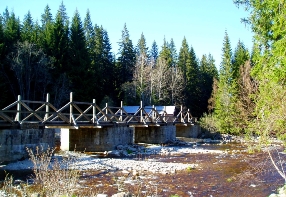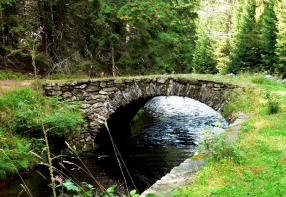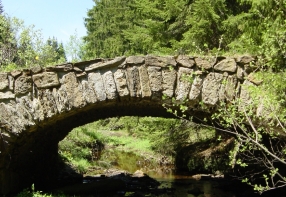Gate bridge – Rechle
The seventy-two metres long gate bridge is located at about half-way from Modrava to Antýgl and is a faithful replica of the historical bridge with 2 metres high trapezoid hanging trusses. The bridge did not serve only to the river spanning but also as a gate conducting floated timber and water from the Vydra river into the Vchinicko-tetovský Floating Canal. The operation of the gate bridge was concluded in 1953 since when it was falling to disrepair until 1999. It was nevertheless fully restored in 2000 and we can therefore admire its original beauty ever since. A car park is located nearby the gate bridge to enable tourists to take a look of the bridge and the floating canal.
Vchynicko-tetovský Floating Canal is an artificial watercourse of 13,6 km built in 1799-1801 according to the design of the Schwarzenberg's architect and engineer Josef Rosenauer. The reason for its construction consisted in the necessity to bypass the unnavigable section of the Vydra for the purpose of timber floating, which has preserved the beauty of the natural stream-bed filled with extraordinary boulders up to date. In 1799, there were 200 workers participating in construction of the canal and their number gradually increased to 2500. The construction was completed in spring 1801 and floating of logs could be initiated. During the canal construction there were also works carried out on the Otava river-bed, which was cleared from boulders and 13 weirs were built along the stream to improve its navigability. Further on, it was necessary to regulate the Vltava river stream to enable the rafts of the Šumava logs navigate down to Prague. The whole journey to Prague took the rafters three or four days, depending on the water level.
The Prince of Schwarzenberg was granted the privilege of navigation in 1801, which authorized him for the period of thirty years to transport the Šumava timber to Prague. The privilege was extended for another 30 years after expiration of the original one. Prague citizens nevertheless started to use coal for heating in the second half of the 19th century. Coal was cheaper, as well as its transport on the emerging railways. For this reason rafting towards Prague started to gradually decrease. The Vchynicko-tetovský Canal was nevertheless used for transporting of timber closer to human dwellings until 1958, when the last navigation took place. It is estimated that about four million cubic metres of timber was transported by the canal in course of its existence.
The floating canal is listed as a technical monument.



